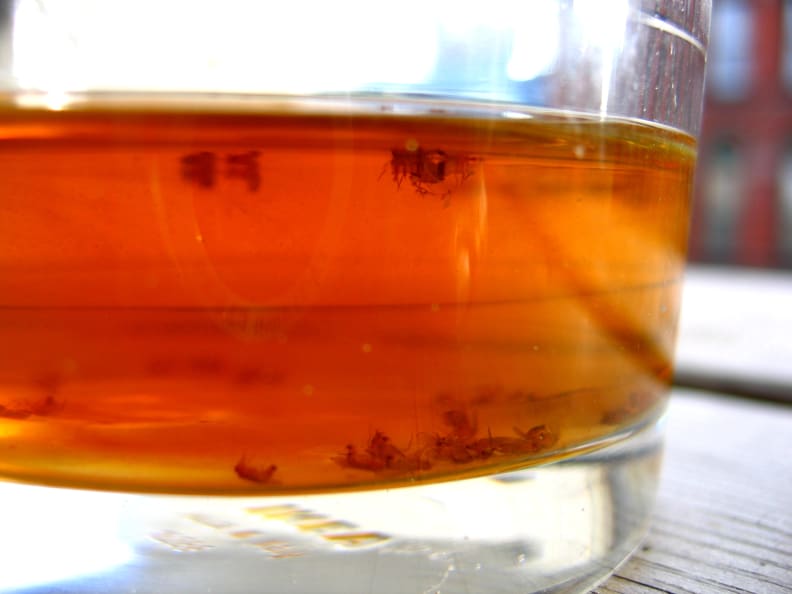How to Get Rid of Fruit Flies Without Vinegar
Sadly, it doesn't take much to start a fruit fly infestation in your home. Whether it's a mushy banana in the pantry, or strawberries that were accidentally left out for a couple of days, these tiny bugs will take any opportunity to set up camp in your kitchen. Before you know it, you're outnumbered and overwhelmed by these rapidly-reproducing and tenacious insects that are attracted to the smell of fermenting fruit.
It only takes a week for a new generation of fruit flies to spawn.
In fact, it only takes about a week for a new generation of fruit flies to spawn, and they're not at all picky about where they reproduce. The old adage about "life finding a way" has never been truer than when talking about these swarms of hellish kitchen creatures.
But before you rush out to a hardware store to stock up on traps, consider a few of these do-it-yourself solutions that take advantage of items you probably already have in your house.
Apple cider vinegar

They won't be able to resist the sweet smell of apple cider vinegar, and it will cost them dearly.
When it comes to eliminating fruit flies, appealing to the fly's taste for sweetness is the name of the game. Take a small bowl or ramekin of apple cider vinegar, cover it with plastic wrap, and use a fork to poke several holes through the top. Finally, place the bowl near the source of the infestation, or where the flies appear to be congregating.
Don't stop with one bowl, either—set up an armada of them around your sink, trash can, and pantry.
Here are two critical things to remember when crafting your apple cider traps: First, make sure the holes in the plastic wrap aren't too big. You're looking for basic, pinhead-sized holes that will allow the flies to enter but will ultimately be too small for them to grab onto and escape. Second, the plastic wrap needs to be as taut as possible around the side of the bowl, otherwise the flies will just crawl out the side.
The benefit of the vinegar-in-the-bowl technique is its visibility; you're able to check up on the carnage at the end of each day and determine how effective (or ineffective) your traps have been.
Wine bottle
So you had one too many glasses of pinot and now you're paying for it in the light of day. Open wine bottles on the counter aren't just a reminder of why you're hungover—they're also a potential hang-out spot for fruit flies.
Open wine bottles are popular hang-out spots for fruit flies.
But the wine bottle has a secret: Its narrow neck makes it incredibly difficult for these barflies to escape once they're inside. Both red and white wine can be used to make this trap, but red wine seems to work better due to its aromatic nature. As long as there's a finger or two of wine in the bottom of the bottle, you're good to go.
As a bonus, in a pinch, you can use wine in place of the apple cider vinegar for the aforementioned apple cider vinegar fruit fly trap.
Ripe fruit in a jar
If the idea of emptying a bowl full of dead flies and stale liquid isn't your cup of tea, let me first congratulate you on being a normal, well-adjusted person. Next, let me point you in the direction of a dry trap that can be sealed and/or cleaned with relative ease.
Place a ripe piece of fruit—a tomato, strawberry, or banana slice works well—into a jar and fashion a cone out of a piece of paper. Next, stuff the cone into the opening of the jar. This paper cone is your funnel. There are many like it, but this one is yours. Your funnel is your best friend. The fruit will lure your enemy into the jar and your funnel will stop your enemy from escaping.
Once you've secured a satisfactory amount of these terrible things inside the jar, simply seal it up and find something to do with the flies. I recommend hurling the jar into the sun, but if you can't throw that far or if you just want to save a perfectly good mason jar (if, for instance, you want to use it to make dessert), rinse it out and re-use it.
Preventative measures
Due to the break-neck speed at which these heinous nightmare demons reproduce, it's important to act quickly when you've noticed an infestation.
Staying on top of routine kitchen maintenance is a must.
Staying on top of routine kitchen maintenance is a must, especially in the warmer months when fruit flies thrive. Here are a few basic strategies I've implemented into my routine that have served me well over the years. Trust me: I'm a seasoned veteran.
-
Thoroughly rinse out bottles, cans, and containers before adding them to a pile of recyclables.
-
Clean your sink often and pay particular attention to the drain; fruit flies can do pretty well for themselves even if all they have to work with is a slightly dirty drainpipe.
-
Keep a watchful eye on bananas, apples, tomatoes, and any fruits that you don't keep in the fridge. If the food is even remotely close to turning, store it in the fridge or scrap it.
Fruit flies are definitely a menace, but they're not unstoppable. With these tips, and some preventative kitchen maintenance, you can leave all of your encounters with fruit flies where they belong—in the past.
More articles you might enjoy
• This $30 gadget could save you hundreds on groceries
• This one product will save your skin from mosquito bites
• You're cleaning your kitchen wrong
How to Get Rid of Fruit Flies Without Vinegar
Source: https://www.reviewed.com/refrigerators/features/how-to-get-rid-of-fruit-flies-using-household-items